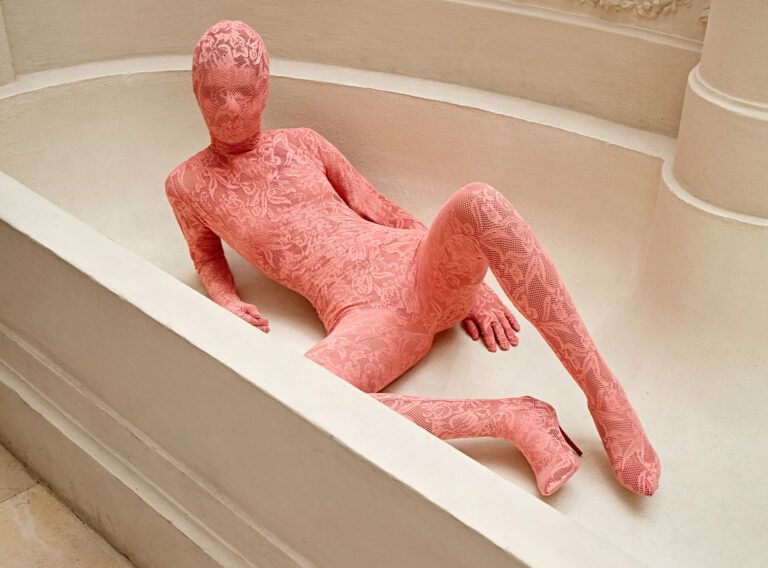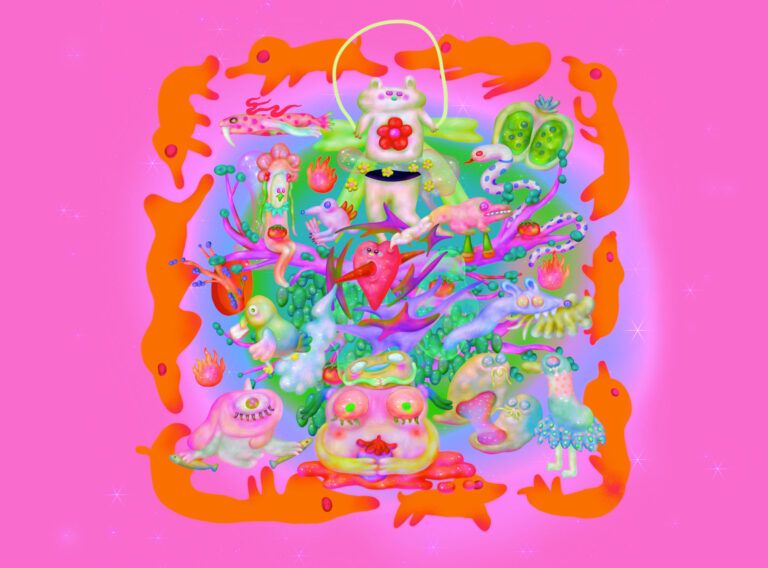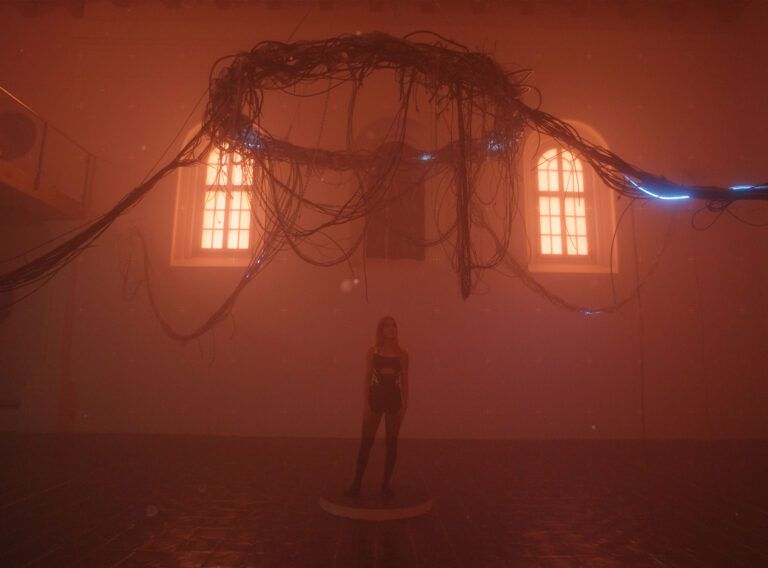How would you describe your process of creating artworks?
I think it’s conscious play and a redeployment of visual codes that interest me at the moment. I hope to achieve a certain sense of dissonance, breaking, and relying on visual codes and viewing habits. I do try to be very conscious of what I am revisiting and for what reasons though!
For the longest time, I thought my drawing and art style had to live up to a certain degree of minimalism and cleanness. I realized at some point that this was an internalization of patriarchal visual coding of what is denoted as serious or professional. I like to think of my work as a container for all the things I collected along the way so far. The mind, like the gut digests what we consume by rearranging, redeploying, and making new connections. There is a great text on storytelling, called “The Carrierbag Theory of Fiction” by Ursula K. LeGuin that really influenced my perspective on creating.
You are presenting your recent project “Gutopia“, where the illustrated characters are based on microbial companions in the gut of a mammal. How did you come up with this idea and where can the animation lead us to?
I think animation has a unique ability to show traditionally erased perspectives. It is better equipped to evade representationalist biases than live action. It can emphasize emotional, imaginative, and subjective knowledge. One could argue that it is because of this subversive potential that this craft is infantilized and denoted as not to be taken seriously as a medium of artistic expression.
It has often been criticized, especially by experimental animators, that the medium is coined as a tool to bring the non-human to life. There is way more to the craft than turning an object into a subject. However, a shift of attention to the “non-human” or a questioning of what human even means is extremely contemporary and needed as we are amidst the human-made sixth great extinction. In my project “Gutopia” I attempt to do just that by anthropomorphizing the part of the anthropos, that is expanding our idea of what is human.

Your project touches on quite sensitive topics like hyper-femininity or chronic illness in connection with gender norms. How do you incorporate these themes into your work so that the audience understands them properly or is confronted with them in some way?
That is exactly the question: How does gender make itself understandable?
I think it would be good to shortly explain the framework of hyper-femininity in the context of illustration and animation. Hyper-femininity is a subversive way of gender expression. It reveals the constructed-ness of gender by overemphasizing the codes that make femininity intelligible. Gender is read, right? It is our visual vocabulary and societal norms that make us read a body as feminine or masculine. Gendered signifiers also exist in the realm of body-less manifestations like animated characters. The gendering of imagined characters is a great way to look at how gender is constructed through the repetition of performative acts.
Some of the traditional codes, established by designers over decades to denote the feminine are the color pink, bows, lashes, and high heels. All things we LOVE but… in traditional western mainstream animation, be it games, films or whatever, the character coded as feminine is ridiculed, tokenized, hypersexualized – all things we DON’T love. Taking these codes used for femmephobic BS and reappropriating them is something a lot of artists incorporate into their style these days.
Many contemporary artists do this in a very refined way referencing artifacts of feminine enculturation. Some of these creatives are LouLou João, Ram Han and Lony Mathis (who is also featured in this issue of SwarmMag). I would describe their art styles as femme, because they display a subversive expression of femininity. In the realities, they invoke a traditionally ridiculed and erased perspective that takes the agentic centerstage. This is a nuanced form of cultural production with a conceptual backbone that is highly subversive of patriarchal structures.
This kind of redeployment of feminine connotated aesthetics is something I wanted to weave into the fabrication of “Gutopia”. Hyperfeminizing a living organ of the human body seemed especially exciting to me. The way a body is gendered and pressed into rigid sex-gender categories becomes intelligible as constructed if you start equipping our bifidobacteria with emphasized gender signifiers, doesn’t it? I was also having a lot of fun making up these little girlies swarming inside us.
Bacteria subvert traditional conceptions of what a human or individual is. The patriarchies’ answer for this was always the white hetero-cis man, completely detached and above his surroundings. If you think about how bacteria are usually portrayed, they are often the villains of the body, symbols of death, or enemies to the immune system in weird military metaphors. They are reminders of a living, boundary-less body that threatens to triumph over the intellect and binds it to earth. They have a lot in common with the feminine subject and its role as “other” throughout history. I just thought I made a nice network of connections that would make a suitable container to tell a different story.
As far as chronic illness is concerned I must say that I really rather grappled with my own chronic illness. I didn’t try to make an understandable point. I think creating moments that are engaging with a perspective one doesn’t necessarily understand is something really cool. Sadly, we are often told to feel stupid or at fault instead of curious if we don’t understand. This I think breaks a lot of ties necessary for coexistence.
All the character designs and loops showcased alongside this interview are excerpts from a body of work that will eventually take the shape of an animated short. I think the spoken text that will accompany Gutopia’s visitors throughout the film is quite crucial to get the feeling I’m trying to communicate. So stick around!

Have these themes been in your work for a long time, or is there anything new you intend to build on in the future?
Ok, here comes the Gutopia origin story:
No, they haven’t, they stem from my own lived experience. I have been unable to work with my right arm/hand for about two years due to my chronic illness. Becoming chronically ill transformed my perspective a lot. “Realities” about your body change depending on the health professional you talk to. It is an exhausting drag of diagnosis, misdiagnosis, and medical gaslighting. Doctors will straight up deny your lived experience. Our ability to interact with the world is very dependent on the formations of knowledge production our reality is embedded in.
Is “undiagnosable” “not sick”, or does this reality lie outside our knowledge? Is it invisible or erased? How does an unknowable perspective feel? I personally felt very invisible, isolated, and sad.
Additionally, I experienced how my illness supercharged the identity factors that intersect within my position. While the privilege of access to affordable healthcare became extremely apparent to me, I was often gaslighted because I was assigned female at birth. I realized how I had internalized patriarchal mechanisms of control directed at the feminine body. The hardest to shake was the normalization of my own pain and the fear of being perceived as “the woman using her health to get attention”.
In a patriarchal society, the feminine subject, as well as the person with chronic illness, are perpetuated as deceivers. This interlock of stigma around chronic illness and feminine self-embodiment affected my research for this project. Taking up space with your body/ perspective in a way not serving (even countering) the patriarchy/ capitalism is the subversive potential I found while making Gutopia.
I think this led me to my decision of making an animated film playing inside the body.
When I learned about my microbiome and the unknown vastness of microbial dark matter inhabiting the large intestine, it blew my mind. I was like: “THIS is just sci-fi!”. This was something I didn’t know, which seemed so absolutely outside the imaginable: There is a part of every living thing that is collecting these little creatures, that are covertly in charge of everything.
Thinking about my microbial companions allowed for my FurReal Friends-, Tamagotchi-, Nintendogs-mind to take over. It equipped me with another perspective on caring about my chronically ill body. I wanted to create a reality about them that is cute, complicated, hyper-feminine, and empowered.
Are there any particular relations in the human-animal or human-human (microbial) relationship in your illustrations/animations? If yes, can you tell us some more details?
I think I am interested in the human as holobiont, meaning the human, composed of both microbial and non-microbial cells. Many microbiologists argue that we should start thinking of humans as microbial ecosystems or multispecies collectives. Bacteria disrupt the traditional assumptions of “The Individual”. The part of us that is our microbiome influences our scent, behavior, mental health, appetite, physiology and we are just scratching the surface.
The holobiont functions as a biological entity, yet it is open to species entering and exiting the open boundary of the body. I think this perspective brings with it a fascinating worldview which doesn’t have the patriarchal human at its center but a creature of interactions sensible to its world by default.

Your style is pretty colorful, who or what is your biggest inspiration? And how does your style develop over time?
Right now, I would rather convey complexity, maybe even complication than simplification. I am currently interested in rather maximalist compositions. But the complexity of the designs, whether color- or shape language-wise was also a conceptual decision. I realized how the images found about microbiomes (scientific illustration, 3D models) do not at all live up to the messiness and entanglement of our gut. Some of the works that have influenced this project a lot are the anime “Kaiba” directed by Masaaki Yuasa, David S. Goodsell’s aquarelles of microbiology, the paintings of Kinke Kooi, Karen Barad’s book “Meeting the Universe Halfway: Quantum Physics and the Entanglement of Matter and Meaning” (so much for engaging with something I don’t fully understand) and the book “Staying with the Trouble: Making Kin in the Chthulucene” by Donna Haraway. I feel very inspired and empowered by Hyperpop artists like Hannah Diamond, Lil Mariko and Slayyyter, and femme culture. Finally, I think something that played a part in setting me on the path of animation and is coming back in a big way in this project are my childhood toys. The weird mechanics and material qualities of interactive toys targeting young girls as consumers throughout the 90s were something else and I was obsessed with them. Two of my favorites were Shampochie the showering dog and Trendmaster’s WuvLuv the birthing robot. So haunted, so cute!

Within the framework of our current theme “Who Let the Dogs Out”, what animal would you like to have as a lifetime companion (could be realistic or fantastic) 🙂 ?
I’m a simple gal, I want a dog!






